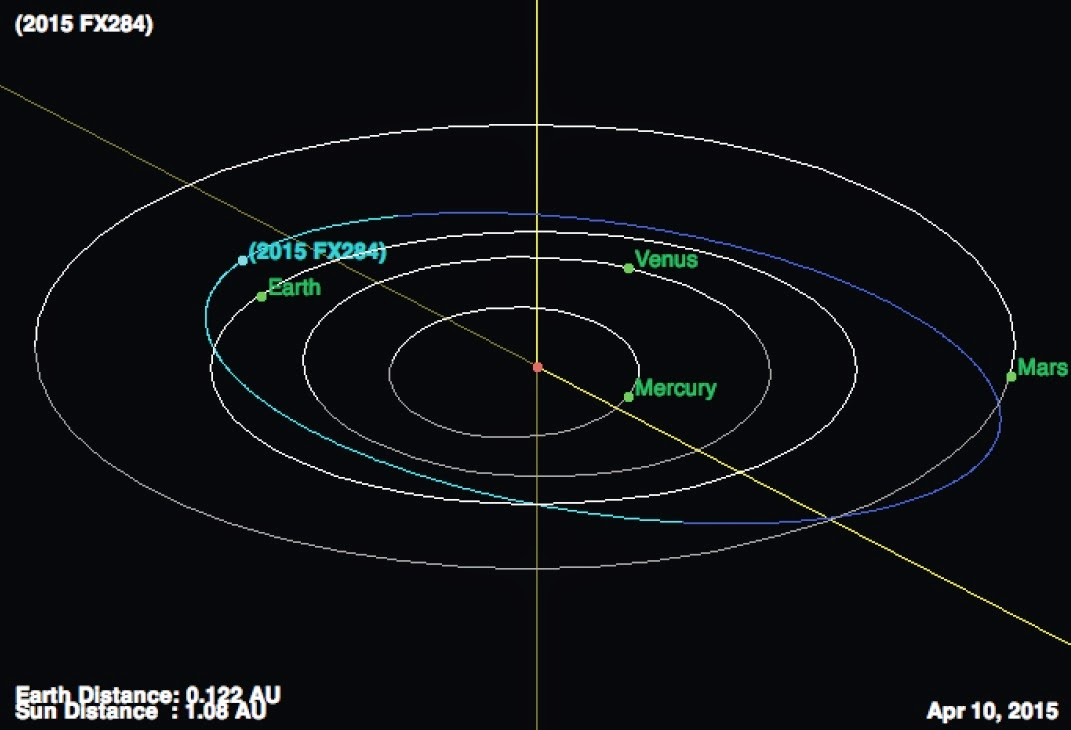Asteroid 2015 FS33 passed by the Earth at a distance of 9 377
000 km (24.4 times the average distance between the Earth and the Moon,
or 6.27 % of the average distance between the Earth and the Sun),
slightly before 8.00 pm GMT on Wednesday 8 April 2015. There was no
danger of the asteroid hitting us, though had it done so it would have
presented a genuine threat. 2015 FS33 has an estimated
equivalent diameter of 93-210 m (i.e. it is estimated that a spherical
object with the same volume would be 93-210 m in diameter), and an
object of this size would pass through the atmosphere and directly
impact the ground with a force of about 30-400 megatons (roughly 1750-23 500 times the explosive energy of the Hiroshima bomb),
causing devastation over a wide area and creating a crater 1.0-3.25
kilometers across, and resulting in global climatic problems that could
last for years or possibly decades.
The calculated orbit of 2015 FS33. JPL Small Body Database.
2015 FS33 was discovered on 21 March 2015 (eighteen days before its closest approach to the Earth) by the University of Arizona's Kitt Peak-Spacewatch Project at the Steward Observatory in
the Catalina Mountains north of Tucson. The designation 2015 FS33
implies that it was the 843rd asteroid (asteroid S33) discovered in the
second half of March 2015 (period 2015 F).
2015 FS33 has
an 523 day orbital period and an eccentric orbit tilted at an angle of 13.3° to the plane of the Solar System, which takes it from 0.47 AU from
the Sun (i.e. 47% of the average distance at which the Earth orbits
the Sun, considerably inside the orbit of Venus) to 2.07 AU from the Sun (i.e. 207% of the average distance at
which the Earth orbits the Sun, greater than the distance at
which the planet Mars orbits the Sun). It is therefore classed as an
Apollo Group Asteroid (an asteroid that is on average further from the
Sun than the Earth, but which does get closer). This also means that
close encounters between 2015 FS33 and the Earth are quite common, with
the last having occurred in September 1923 next predicted for April 2101. 2015 FS33 also has occasional close encounters with the planet Venus, with the last having occurred in January 1925.
See also...
 Asteroid 2015 FX284 passes the Earth. Asteroid
2015 FX284 passed by the Earth at a distance of 18 250 000 km (47.5
times
the average distance between the Earth and the Moon, or 12.2% of the
average distance between the Earth and the Sun), slightly after 10.40 pm
GMT on Tuesday 7 April...
Asteroid 2015 FX284 passes the Earth. Asteroid
2015 FX284 passed by the Earth at a distance of 18 250 000 km (47.5
times
the average distance between the Earth and the Moon, or 12.2% of the
average distance between the Earth and the Sun), slightly after 10.40 pm
GMT on Tuesday 7 April... Comet C/2012 F3 (PANSTARRS) reaches its perihelion. Comet
C/2012 F3 (PANSTARRS) reached its perihelion (the closest point on its
orbit to the Sun) on Tuesday 7 March 2015, when it was 3.46 AU from the
Sun (i.e. 3.46 times the average distance at which the Earth orbits the
Sun). The comet is visible only with a...
Comet C/2012 F3 (PANSTARRS) reaches its perihelion. Comet
C/2012 F3 (PANSTARRS) reached its perihelion (the closest point on its
orbit to the Sun) on Tuesday 7 March 2015, when it was 3.46 AU from the
Sun (i.e. 3.46 times the average distance at which the Earth orbits the
Sun). The comet is visible only with a...
Asteroid
(429094) 2009 SG2 passed by the Earth at a distance of 13 140 000 km
(44.4 times the average distance between the Earth and the Moon, or 11.4
% of the average distance between the Earth and the...
Follow Sciency Thoughts on Facebook.


